Featured Comment:
“While visiting Japan with my partner last year, sukiya became a breakfast staple for us, upon returning to Australia the lack of a good gyudon became depressingly clear.. then I discovered this recipe. it is almost a perfect recreation. you are a god among men, thank you so much.”
– Callum
What is Gyudon?
Ever been craving that taste of authentic fast food style gyudon? If you’ve ever enjoyed this classic and can’t find it where you live now, you’re not alone. During my years living in England, I desperately missed the simple perfection of a good beef bowl from places like Sukiya, Yoshinoya, and Matsuya.
Gyudon (牛丼) is a delicious bowl of thinly sliced beef and onions simmered in a delicious Japanese dashi sauce and then served on rice. The meat absorbs the flavor, and the sauce is poured over the rice. It’s seriously so GOOD!
In Japanese, “gyu” (牛) means cow or beef and “don” (丼) is short for donburi, which means rice bowl. So the dish is only made with beef. Saying that, there is also a pork rice bowl called “butadon.”
The history of gyudon goes all the way back to Meiji era (1868-1912) and used to be called “gyu-meshi” which literally means beef rice.
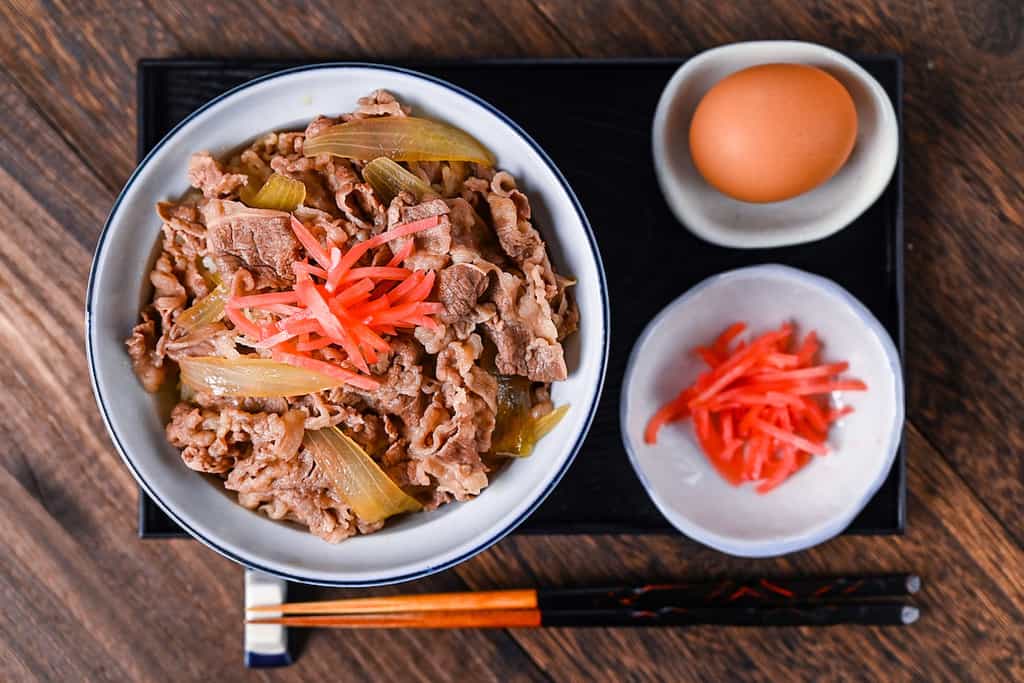
How to Choose the Perfect Beef
The star of gyudon is, of course, the beef. Selecting the right cut is crucial for authentic flavor and texture.
It is worth noting that the major Japanese gyudon chains do not use premium Japanese wagyu or even Japanese beef for their beef bowls. Instead, they use imported beef. This is great news for those looking to recreate authentic gyudon outside Japan.
- Sukiya (すき家): Short plate beef, primarily from North America (USA, Canada), Australia, or Mexico
- Yoshinoya (吉野屋): Short plate beef, mainly from the USA and Canada
- Matsuya (松屋): Short plate beef, from the USA or Canada
While Yoshinoya is more recognized internationally, particularly in the United States, Sukiya has the most locations in Japan, followed by Yoshinoya and then Matsuya.
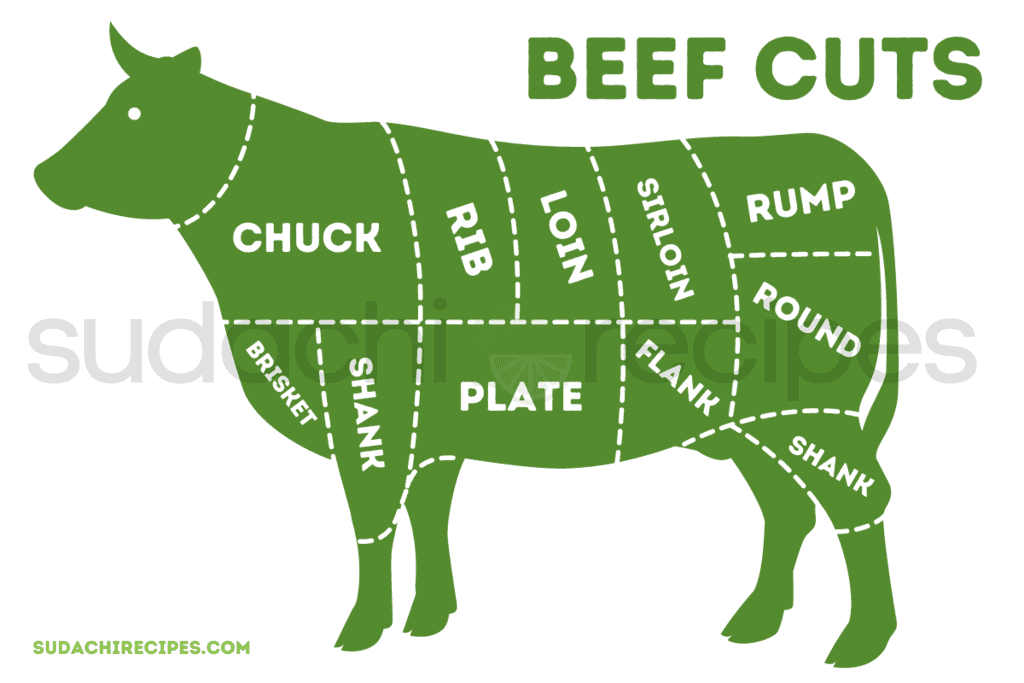
Short plate, also known as beef plate, is a cut from the belly area of the cow, located just below the ribs. It has the perfect balance of meat and fat that gives gyudon its signature flavor and tenderness when simmered.
So, for the most authentic gyudon experience, look for thinly sliced short plate from North America. However, if that’s not available, here are excellent alternatives:
- Best option: Purchase short plate, flank steak, or skirt steak and partially freeze it until firm-not frozen solid (approx 30-45 minutes) before slicing it very thin (1-3mm) with a sharp knife or a meat slicer
- Second alternative: Pre-sliced beef labeled “for Hot Pot” or “Shabu Shabu” at Asian markets
- Accessible alternative: Shaved steak used for Philly cheesesteaks
The ideal thickness for gyudon beef is approximately 1-3mm. If asking a butcher to slice beef for you, request it “shaved” or “paper-thin” for hot pot.
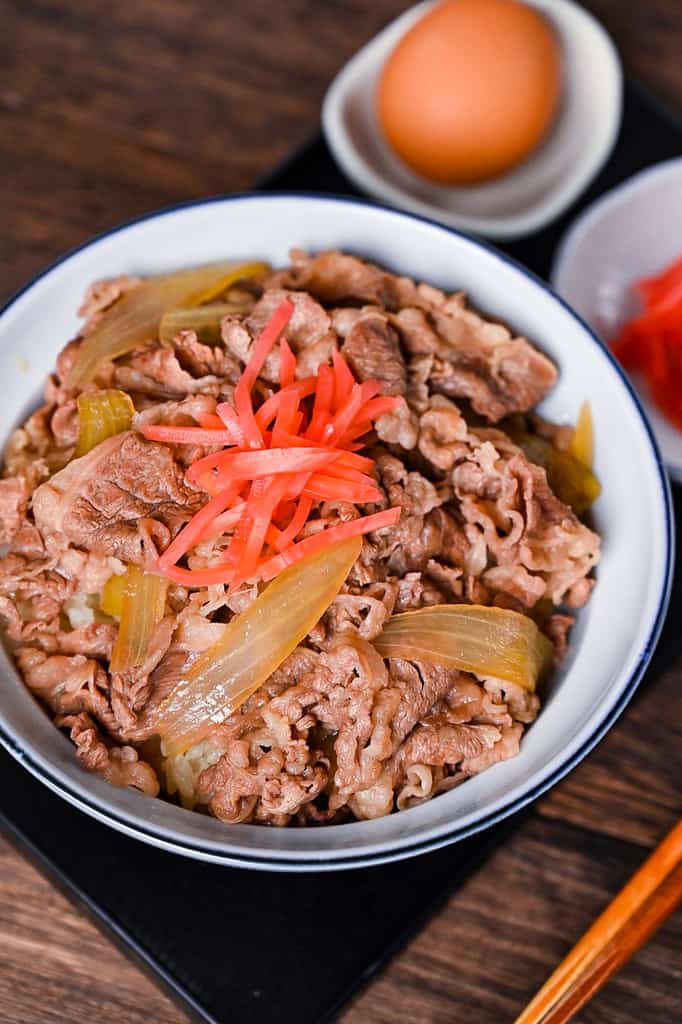
Visual Walkthrough & Tips
Here are my step-by-step instructions for how to make Gyudon at home. For ingredient quantities and simplified instructions, scroll down for the Printable Recipe Card below.
If you prefer to watch the process in action, check out my YouTube video of this Gyudon recipe for a complete visual walkthrough!
Cut the yellow (or white) onions into thick wedges by slicing them from pole to pole (rather than into rings) and gently break the layers apart.
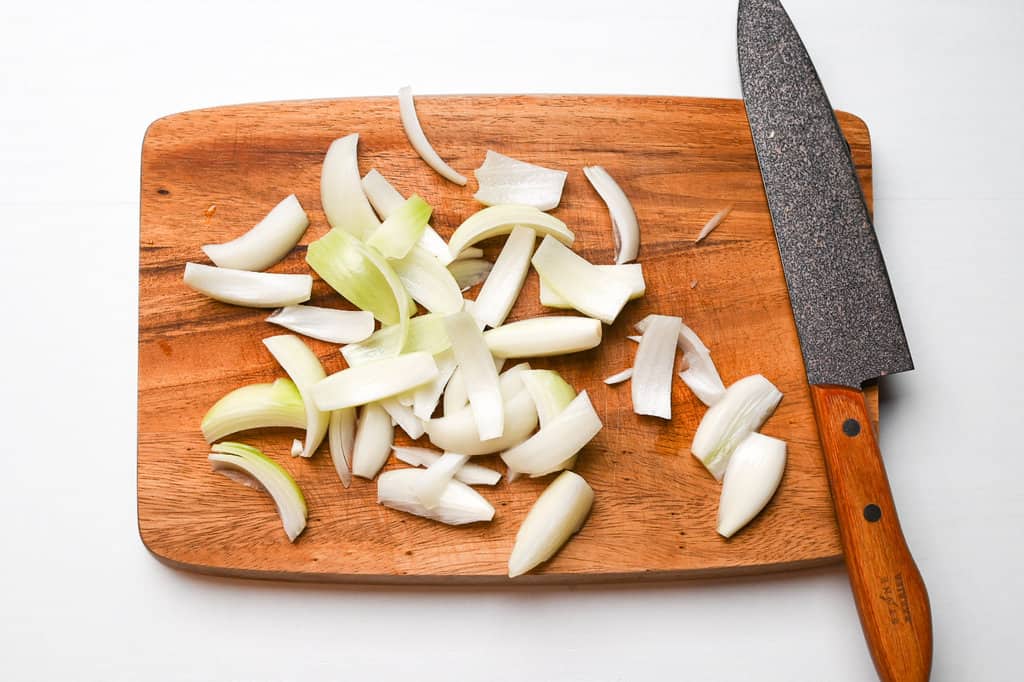
Cutting onions radially rather than into rings helps them cook more uniformly and prevents them from becoming mushy too quickly.
Add the dashi stock, Japanese soy sauce, mirin, sake, light brown sugar, Japanese light soy sauce, grated ginger, grated garlic, and Chinese-style chicken bouillon powder to a medium saucepan and mix over medium heat.
Light soy sauce has a slightly higher salt content and brings a cleaner, saltier flavor, while also helping to keep the broth from becoming too dark.
Dark soy sauce, on the other hand, adds depth, color, and a bit of sweetness.
Using both helps balance flavor and appearance. That said, it’s a subtle difference in this particular recipe, so if you only have dark soy sauce (regular Japanese soy sauce) on hand, it will still work just fine.
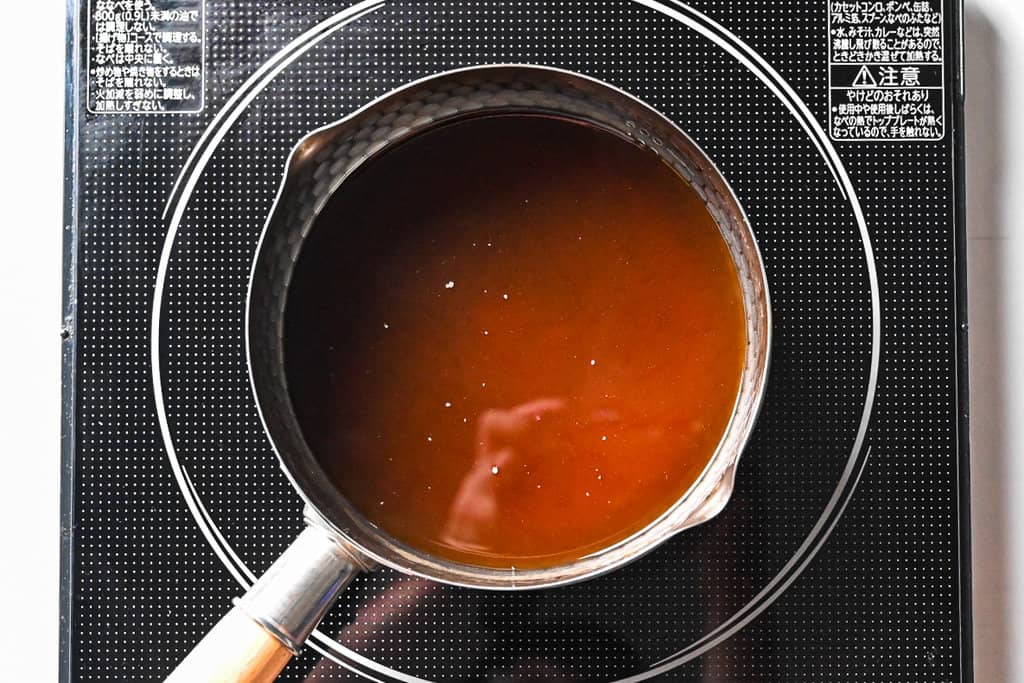
- If you like sophisticated flavors, try making your own dashi stock with dried bonito and kelp.
- If you’re looking for a clean yet convenient option, dashi packets are great.
- And if you want to add some junky flavor, dashi granules are a good choice.
Don’t stress too much – gyudon is forgiving, and any of these options will make delicious gyudon. Choose what fits your time constraints and ingredient availability.
This combo of ingredients makes the perfect umami-rich base for gyudon:
- Dashi stock: glutamic acid (pure umami)
- Soy sauce: salt and complexity
- Mirin & Sugar: balance with sweetness
- Ginger and Garlic: enhance the overall flavor profile without overwhelming
- Bouillon powder: creates the slightly “junky” flavor like Japanese gyudon chains
Add the prepared onion wedges to the simmering broth and bring to a gentle boil. Once bubbling, lower the heat slightly to maintain a steady simmer until the onions soften to your liking, about 5 minutes or so.

Add the thinly sliced beef to the pan, separating the pieces as you add them to prevent clumping.

Continue to simmer just until the beef is cooked through, about 1-2 minutes depending on thickness. The meat should still be tender.
Overcooking is the most common mistake when making gyudon. The thin beef slices cook extremely quickly. They need just enough heat to change color while remaining tender. Watch carefully and remove from heat as soon as the beef is about 90% cooked, as residual heat will finish the cooking process.
If you want to add a little extra refinement, you can try the “shimofuri (霜降り)” technique. Just briefly dip beef slices in boiling water for 15 seconds, then immediately transfer them to cold water. This removes excess blood and fat, giving you a cleaner flavor and keeping the slices from sticking together during cooking.
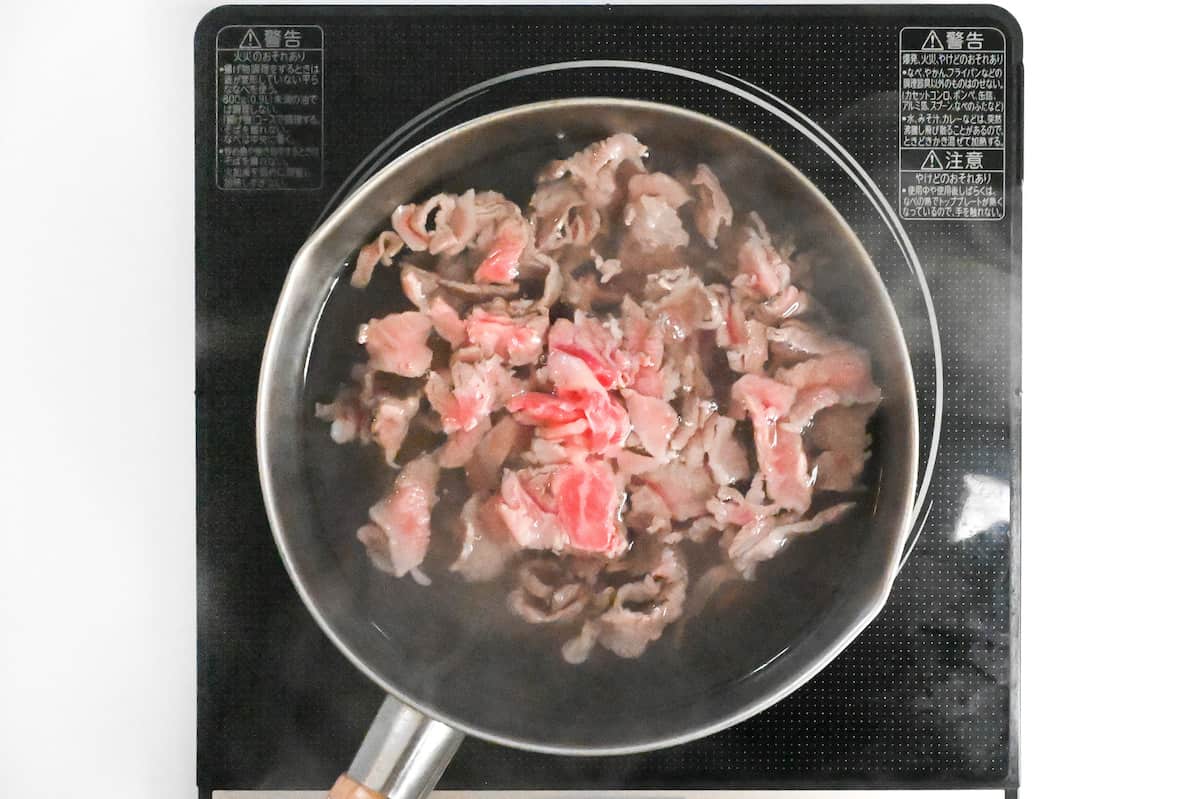
But we’re making fast food style gyudon today, so you don’t have to do this.
Divide the freshly cooked Japanese short-grain rice into serving bowls, filling them about 2/3 of the way up. Arrange the beef and onions on top of the rice. Spoon 1-2 tablespoons of the flavorful broth over each portion, allowing it to soak into the rice.

If you want to make authentic gyudon, you’ve got to use Japanese-style short-grain rice. Check out my recommended rice brands If you’re interested.
For the best eating experience, serve gyudon immediately while still hot.
Garnish with your favorite toppings. Red pickled ginger (benishoga) and Japanese chili powder (shichimi togarashi) are classic choices that add brightness and gentle heat to cut through the richness of the beef.
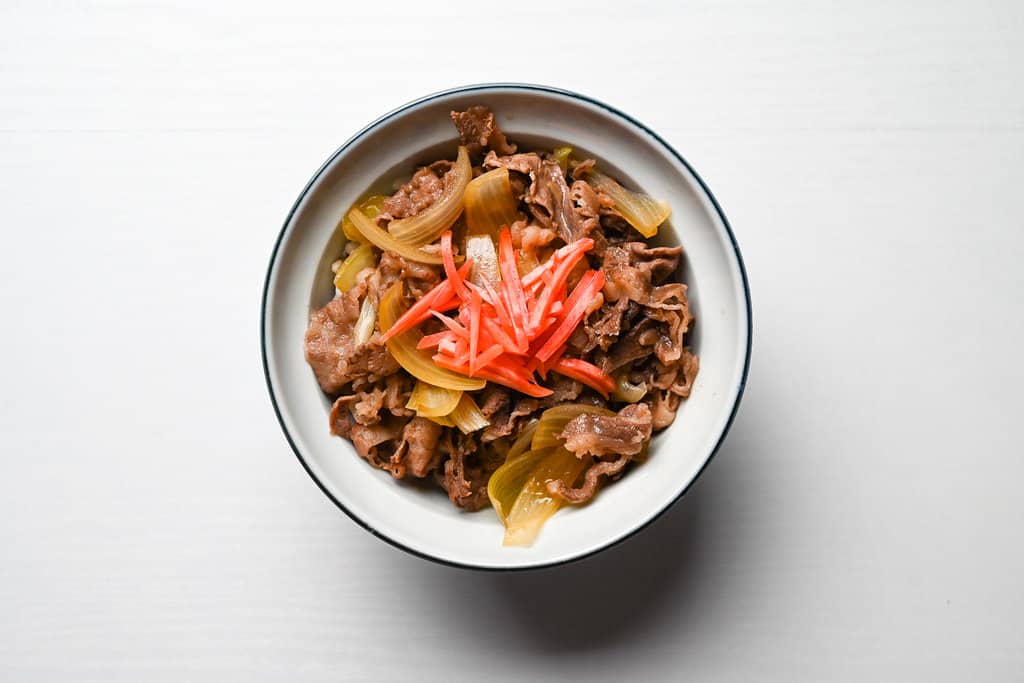
While classic toppings are definitely delicious enough, Sukiya offers the following topping options:
- Kimchi
- Chopped green onion
- Melted cheese
- Ponzu on grated daikon radish
- Okra
- Pasteurized raw egg/egg yolk (you can also use onsen tamago or soft-boiled egg)
- Salad (with broccoli, shredded cabbage and sweetcorn)
Essential Tips & Tricks
- Beef thickness matters: Look for beef sliced 1-3mm thick (paper-thin).
- Don’t overcook the beef: Cook just until it changes color. The residual heat will finish cooking it.
- Separate beef slices: As you add the beef to the broth, gently separate the slices to prevent them from clumping together.
- Control your heat: Once the broth boils, reduce to a gentle simmer. Aggressive boiling will toughen the meat.
- Hot rice is essential: Always use freshly cooked, hot Japanese rice. Cold rice won’t absorb the flavors properly.
With these simple tips in mind, you’re set for success every time you make Gyudon.
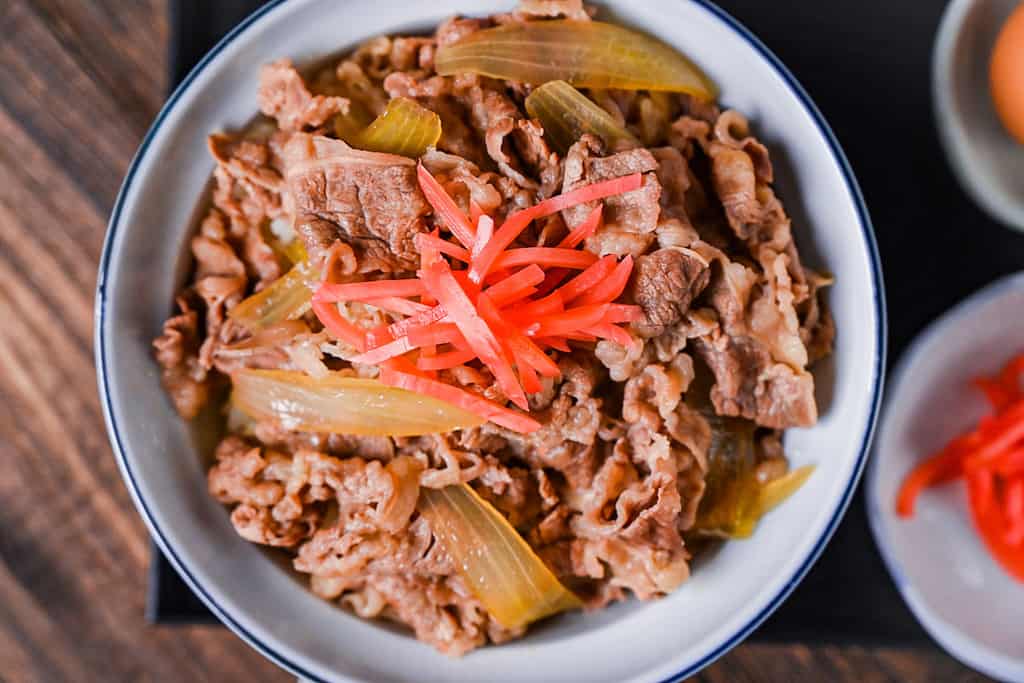
Meal Prep & Storage
For gyudon, you can make ahead some of the components beforehand.
- Prepare the broth (without beef) up to 3 days ahead and refrigerate in an airtight container.
- Cook fresh rice on the day (or use freshly reheated rice – I often keep cooked rice in the freezer for convenience).
- Cook the beef fresh in the reheated broth when ready to serve
For storage, refrigerate leftover gyudon within 2 hours of cooking in airtight containers. Consume refrigerated leftovers within 1-2 days. For best results, store beef and onion mixture separately from the rice.
Serving Suggestions
- Authentic Japanese Miso Soup
- Fresh Side Salad
- Japanese Pickles
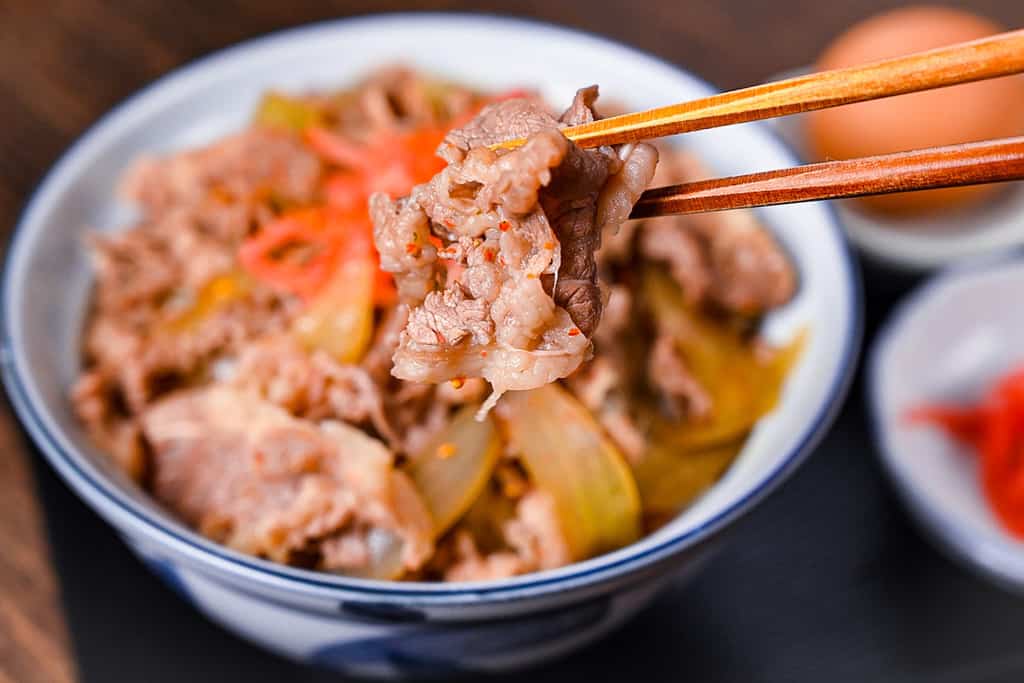
I hope you enjoy this Sukiya-style Gyudon Beef Bowl recipe! If you try it out, I’d really appreciate it if you could spare a moment to let me know what you thought by giving a review and star rating in the comments below. It’s also helpful to share any adjustments you made to the recipe with our other readers. Thank you!
More Copycat Recipes
- Yoshinoya Copycat Pork Rice Bowl (Negi Shio Butadon)
- Saizeriya Milano Doria
- Gindaco’s Takoyaki
- Bikkuri Donkey Hamburger Steak
Hungry for more? Explore my copycat recipe collection to find your next favorite dishes!
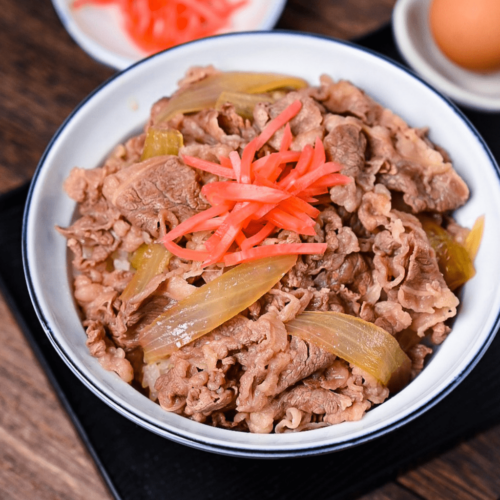
15-Min Gyudon (Sukiya-Style Japanese Beef Bowl)
Ingredients
- ½ onion large, yellow or white
- 150 g thinly sliced beef paper-thin (1-3mm), short-plate is the best option
- 2 portions cooked Japanese short-grain rice
- red pickled ginger (benishoga) optional topping
- Japanese chili powder (shichimi togarashi) optional topping
Broth
- 300 ml dashi stock
- 2 tbsp Japanese dark soy sauce (koikuchi shoyu)
- 2 tbsp mirin
- 2 tbsp sake or dry white wine
- 1 ½ tbsp light brown sugar or other sugar
- 1 tsp Japanese light soy sauce (usukuchi shoyu) or use regular soy sauce if unavailable
- 1 tsp grated ginger root or ginger paste
- ¼ tsp grated garlic or garlic paste
- ½ tsp Chinese-style chicken bouillon powder
My recommended brands of ingredients and seasonings can be found in my Japanese pantry guide.
Can’t find certain Japanese ingredients? See my substitution guide here.
Instructions
- Cut ½ onion into wedges.

- Take a saucepan and add all the broth ingredients (300 ml dashi stock, 2 tbsp Japanese dark soy sauce (koikuchi shoyu), 2 tbsp mirin, 2 tbsp sake, 1 ½ tbsp light brown sugar, 1 tsp Japanese light soy sauce (usukuchi shoyu), 1 tsp grated ginger root, ¼ tsp grated garlic and ½ tsp Chinese-style chicken bouillon powder). Mix well and place on the stove over a medium heat.

- Add the onion to the broth and bring to the boil. Once bubbling, lower the heat slightly and simmer until the onions are softened to your preference.

- Add 150 g thinly sliced beef to the broth and continue to simmer until cooked through.

- Divide 2 portions cooked Japanese short-grain rice in serving bowls and top with the beef and onions. Drizzle 1-2 tbsp of the broth over each bowl.

- Top with red pickled ginger (benishoga) and Japanese chili powder (shichimi togarashi). (See in post for additional topping ideas.)

- Enjoy!
Video
Notes
- Use thinly sliced beef (1-3mm thick) like short plate, flank steak, or “for Hot Pot” packages for authentic texture and flavor.
- If you want to make authentic gyudon, you’ve got to use Japanese-style short-grain rice.
- Prepare dashi stock using one of these options: homemade with dried bonito flakes and kelp, instant granules, or dashi packets.
- Serve with optional side dishes like miso soup, Japanese pickles, or a simple salad.
- Explore classic toppings beyond benishoga: soft-boiled egg, green onions, melted cheese, or kimchi add different variety.
- Store leftovers in airtight containers in the refrigerator for up to 2 days, keeping beef mixture separate from rice.
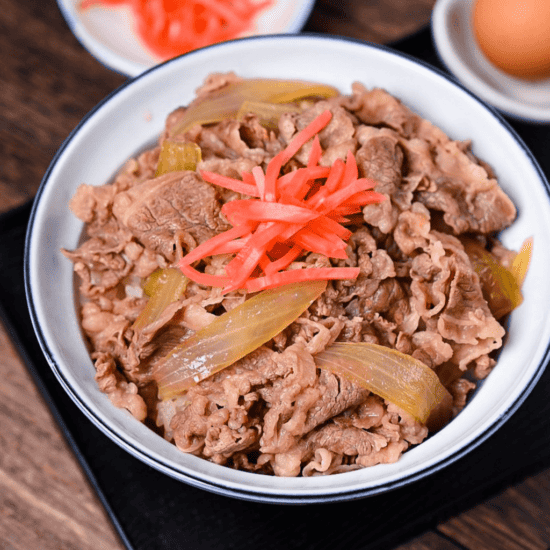






The sauce was tasty and the meal was easy to make but the beef did not soak up the sauce as I would like. It often was tasteless without the sauce. Thanks for the easy steps and I look forward to trying more recipes.
Thank you for the comment and feedback! 🙂
This was super tasty! I loved it, especially that sauce. So easy and healthy too! I’m gonna try it with pork.
Thank you so much, I’m glad you liked it! Pork is a great idea 🙂
My mother- and father- in law (Brazilian Japanese) loved this recipe. Said it was better than sukiya and even ate the leftover broth with udon the next day. I use thin cut pork instead of bed because it’s cheaper and substitute rice vinegar for sake because my baby eats it. It’s on dinner rotation a few times a month. Thank you!
I’m happy to hear that you and your family enjoy the recipe, thank you so much!
how much is one portion of rice?
Hi Ben,
A bit tricky to answer this question since it depends on who’s eating. I personally cook about half a Japanese rice cup per person which is about 75g of uncooked rice each. After cooking, this is about 160g of rice. Donburi is typically made with a bit more, about 200-240g of cooked rice per person. It depends on your appetite but I hope this gives you a rough idea!
While visiting Japan with my partner last year, sukiya became a breakfast staple for us, upon returning to Australia the lack of a good gyudon became depressingly clear..
then I discovered this recipe. it is almost a perfect recreation. you are a god among men, thank you so much.
Hi Callum,
Thank you very much for your kind words! Literally made my day!
Yuto
are there any alternatives for mirin and sake to make it halal? thankyou very much.
Hi, you can find some alternative ideas in these dedicated sake and mirin articles below!
Sake:https://sudachirecipes.com/sake-101/
Mirin:https://sudachirecipes.com/mirin/
There was a sukiya restaurant in downtown Calgary but it closed.
The guyudon was also served with wilted (salted) sliced raw cabbage.
It was a delicious side dish.
Hi Fred,
Thank you for your comment and sharing your experience! I didn’t know there was a Sukiya branch in Canada!
Yuto